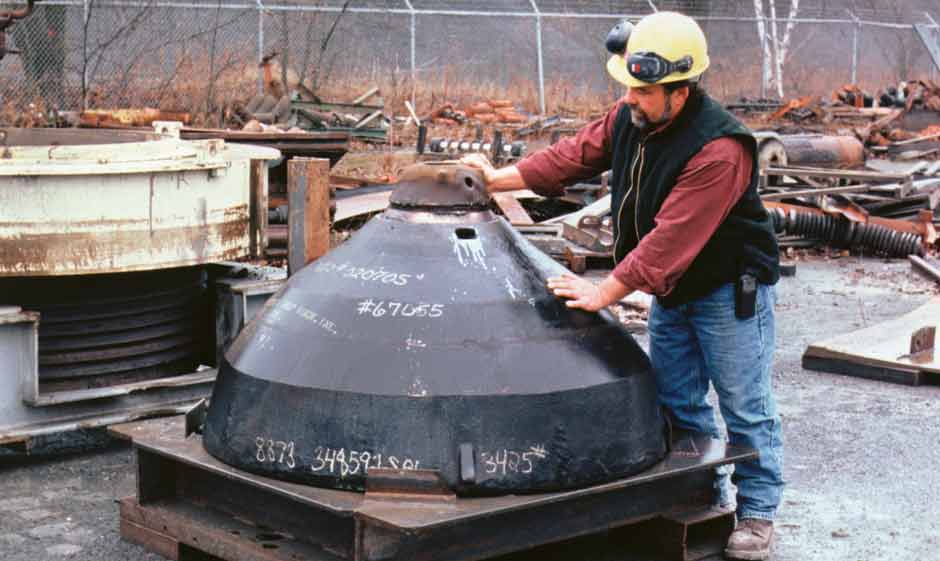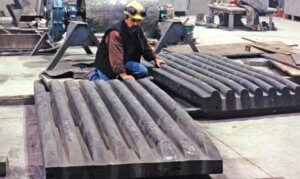Dresser Traprock isn’t easy to mine, but the market makes it worth the effort.
— By Rodney E. Garrett
Some quarries have hard rock that tests at 35,000 to 45,000 psi. Rock pushing 45,000 psi or more certainly is hard. And as for 80,000 psi rock — that’s hard redefined. Very few quarries can boast having rock that has an unconfined compression test result of 80,000 psi, but Dresser (Wis.) Trap Rock Inc. can.
Maybe boast is not the best word to describe a rock that is this hard, for it brings before the company a unique set of challenges not experienced by most others in the rock crushing-screening business. Nonetheless, while this trap rock is difficult to mine, crush and screen, it has attributes that make it a highly desirable rock for producing quality aggregates, construction applications and decorative uses.
Because it is found in the Dresser area, the rock’s proper designation is Dresser Traprock. Dresser Trap Rock Inc. sells its aggregates starting at $12 per ton; decorative boulders are priced up to $60 per ton. So while the mining and production of the Dresser Traprock is a challenge for the company, the market demand for its extensive range of products is widespread. Currently, many of the products are marketed bulk or bagged through retail dealer outlets in five upper Midwestern states.
Crusher maintenance
Dresser Trap Rock Inc. has been mining its Dresser quarry since 1914 and thereby has a good idea as to what mining, crushing and screening methods are cost-effective for hard rock. Each facet of the quarry operations is a story in itself, so this report will focus on the proper crusher maintenance procedures necessary to ensure minimum downtime and efficient crushing production.
Dresser Traprock is not friendly to jaw crushers or cone crushers used to bring the mined rock into marketable products. Its extreme hardness resists fragmentation and in turn, that means the crusher’s parts directly exposed to the rock during the crushing process need to withstand repeated severe impacts.
About 1 million tons of 50 different rock products are produced here annually. Producing 50 different products necessitates a plethora of crushers and screens at the primary, secondary and tertiary stations and beyond. At the primary, there are two jaw crushers: One is a 26-year-old 60×84 built by Allis Chalmers (AC), and the second is a 30-year-old 42×48 built by Hewitt-Robins. The 60×84 crushes 1,500 tph, while the 42×48 crushes 700 tph. These jaw crushers are operated from March to November and are shut down during the winter season.
Rock fragmentation from the blasting is consistent enough that it need not be scalped but fed directly to the jaw crushers. The size fed is 3-ft. minus. All oversize pieces are reduced to crushable sizes using a hydraulic excavator fitted with an impact breaker.
The AC jaw crusher is still a good performer, even after 26 years, according to Rick Demulling, director of operations for Dresser Trap Rock. However, there was a hurdle to be made so the crusher would be more reliable. The original equipment manufacturer (OEM) jaws were a four-section-per-side design, which had to have some of its mounting bolts replaced weekly.
“There were seams created by the four-part-per-side jaws design, and some of those seams would gradually spread apart from the constant rock crushing action,” explained Demulling. “Eventually, the void between the sections was 1/2-in., and that enabled rock pieces to get wedged in between the sections. That in turn created lateral forces, which eventually would shear the mounting bolts.”
Dresser Trap Rock took the problem to Columbia Steel Casting to find a way to build the jaws with two sections per side for eliminating bolt shearing, as well as improving the wear life of the jaws. Demulling said Dresser Trap Rock has worked with Columbia Steel Casting for more than three decades, and “we felt if anyone could solve our problems we were having with this jaw crusher, it would be this company.”
Crushing efficiency
According to Demulling, the redesigned jaws with the two-part system eliminated the seams that caused the bolt shearing. Columbia Steel Casting also designed various tooth forms; now the close-side setting can be reduced from the 10 to 11 in. when using the OEM jaws to 7 to 8 in., yet with the same throughput. In turn, this has meant smaller-sized crushed rock conveyed to the secondary cone for more efficient crushing there.
Not only has there been improved crushing efficiency, but the jaws’ use life has been increased from crushing 900,000 tons to crushing 2 million tons of rock. The cost-savings are also dramatic. Each time the jaw sections are replaced, it costs $30,000 in labor and parts. A change after every 900,000 tons of rock crushed meant a cost of 3.4 cents per ton of rock crushed. That cost has now been reduced to 1.5 cents per ton, or a savings of 1.9 cents per ton. Put another way, it now costs $30,000 in parts and labor to crush 2 million tons of rock, where before it cost $68,000.
Yet another important benefit in using the new jaw design is, according to Demulling, the stretched time intervals between changing liners, thus reducing crushing interruptions.
“The AC jaw crusher has been very good, but Columbia made it much better,” he said. “Over the years, the company has tuned its original jaws design for optimizing production efficiency. This kind of service rendered by Columbia is one we cannot get from anyone else.”
Saving time and labor
The Hewitt-Robins jaw crusher has also been a very good performer but again, the OEM jaws were wearing out too fast. They had to be flipped once a month and replaced after two months using a 60-ton-capacity RT crane and three men. The change took five hours to accomplish. Again, Dresser Trap Rock called on Columbia engineers to design jaws that would have more lasting usable life.
Columbia designed jaws that feature superior metallurgy and last for one year — yet are used to crush the same quantity and size rock. The costs have been reduced significantly: Each jaw change costs $20,000, and while Dresser Trap Rock used to spend $120,000 annually, the costs are now a mere $20,000 a year.
At the secondary, there is a 7-ft. Symons cone crusher that has parts lasting acceptably long, according to Demulling. He said that in the future, he will have Columbia Steel engineers evaluate the feasibility of a custom design to improve production efficiency and/or wear parts life.
“We are getting increased demands for our railroad ballast, so we will want Columbia Steel to design an improved liner where there are not so many fines produced as there are now. What we want is a 2 1/2- x 3/4-in.,” he said.
“I am happy with the brand cone crusher we are using in the tertiary position. It is well-designed and well-built. My only complaint is the wear parts do not hold up very well,” he said. “My 25 years of experience with OEM crusher wear parts has been that many do not hold up as well as the Columbia custom-designed parts with its excellent metallurgy. The same has been true of other non-OEM brands of parts; they do not hold up as well. I certainly do not endorse Columbia products for others because I do not know another quarry’s working conditions. But I do recommend Columbia Steel parts to my company because they have been the most cost-effective wear parts available. It is my responsibility to recommend the most economical parts offered.”
A main reason for the tertiary crusher is to produce granules used for roofing products. The wanted size is a 12 x 40 mesh. A polyhedral shape of the granules is important or the product will be rejected by the roof manufacturers. There are other products made at the same time by including two triple-deck screens in closed circuits. A 2 1/2-in. minus crushed rock is fed to the cone crusher, which reduces it to 3/8 in., 3/16 in., 1/8 in. and the granules. The OEM liner proved not to be very efficient. For one, the salable crushed rock-products yield was only 50 percent to 60 percent. The other 40 percent to 50 percent was not marketable and was discarded. Now, with the Columbia Steel liners in place, 80 percent of the crushed rock is screened into salable products and only 20 percent is discarded as fines.
The crushing efficiency also has improved. Sending the rock through the crusher with the OEM liners and the two triple-deck screens in the closed-circuit configuration, the throughput was 300 tph and the products produced were 30 tph. With the Columbia Steel liners in place, the throughput is 400 tph and the products produced are 60 tph.
It should be noted that the tertiary crusher is operated indoors 12 months per year, usually with a single 12-hr. shift and at times with two 12-hr. shifts. Demulling said the quarry cannot afford to shut down the cone crusher once a month to change liners as they had to in the past.
Further, because the useful life of the OEM liners was just one month, the 12x change-costs totaled $144,000 per year. By switching to Columbia Steel liners, which need to be changed every three to four months, the cost averages only $42,000 per year.
Buy low, pay high
Demulling admits the initial cost for wear parts originating offshore are less than what the Columbia Steel components cost, but when the added usable life is factored in, the domestic parts are the better buy, he said.
“When we also take into account the added value services, including custom redesigning the crusher parts for improved crushing efficiency, the Columbia Steel products are much more economical to use,” he said.
Because every quarry operation is unique, Demulling recommends trying different brand parts and recording how often they must be replaced, as well as the cost of labor to replace them and the throughput efficiency of the rock being crushed. Add into the mix the quality of service received in terms of the supplier’s willingness to modify the wear-parts design that can affect their cost-effectiveness. This, he said, is the only way to decide what brand best serves the quarry company.
About Top-shelf Dresser Traprock
Dresser Traprock is basalt (igneous, volcanic); a rock that is non-porous. Accordingly, with a hardness of 80,000 psi, it is arguably the hardest known rock (at least quarried) in North America. According to Dresser Trap Rock Inc., the Dresser, Wis., deposit is not only the hardest, but it is the greatest concentration of basalt in America.
The rock is so unusual that the company shipped a selection of boulders mined in its quarry to NASA’s Goddard Space Flight Center in Greenbelt, Md., so the agency could test the performance of various brands of rock drills for selecting the best to use later in making probes on the moon.
Dresser Traprock has a long history by first being mined in 1855. There is good reason why this rock has been mined for the past 150 years: Not only does it crush into high-quality construction materials, but it is a mineralogist’s candy store, with many landscape designers specifying the rock in different sizes and forms to express the rock as part of esthetically creative landscape designs.
In its literature, Dresser Trap Rock Inc. describes its mined rock as “a dark, fine-grained igneous rock. It is a unique bluish-grey basalt. As boulders, it exhibits subtle hues of grays, blues, reds, pinks and purples. In crushed aggregate form, its gray color dominates, creating a unique richness unattainable with any other ground cover.”

